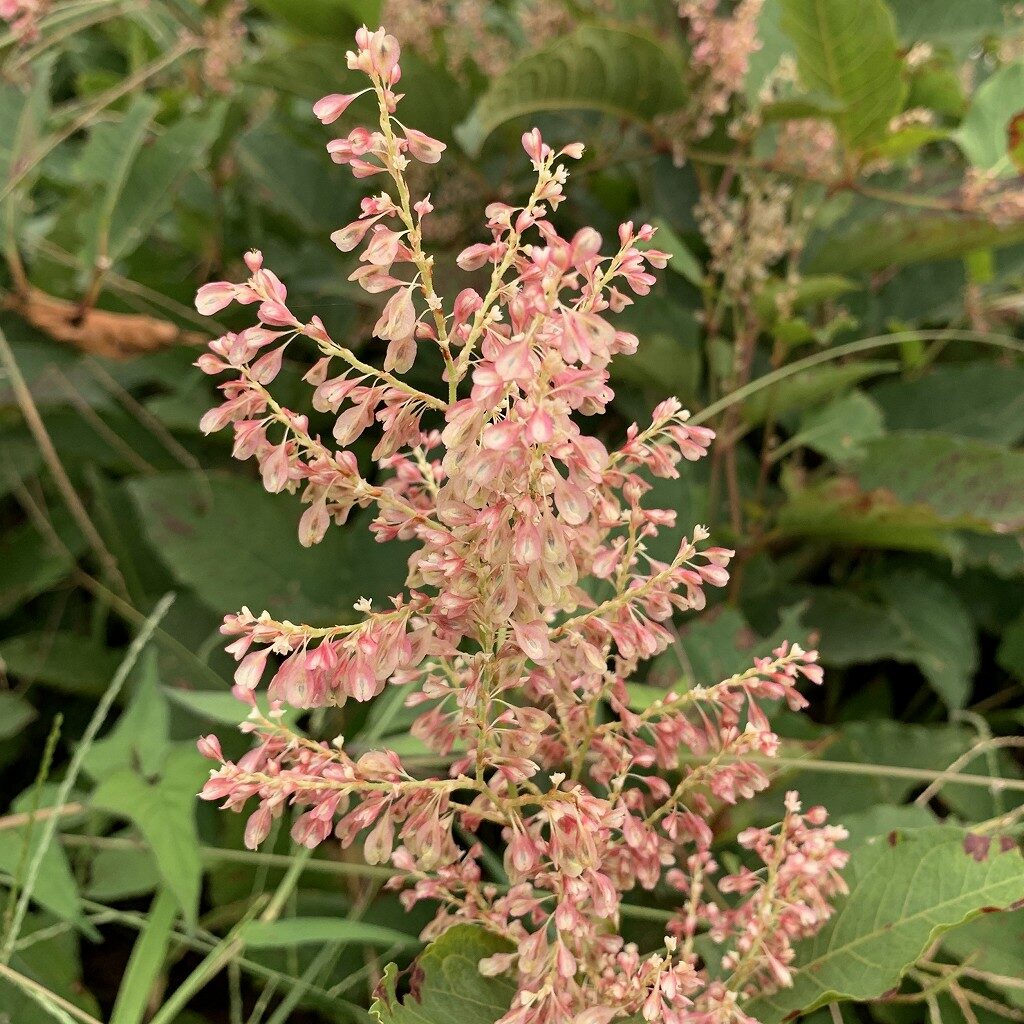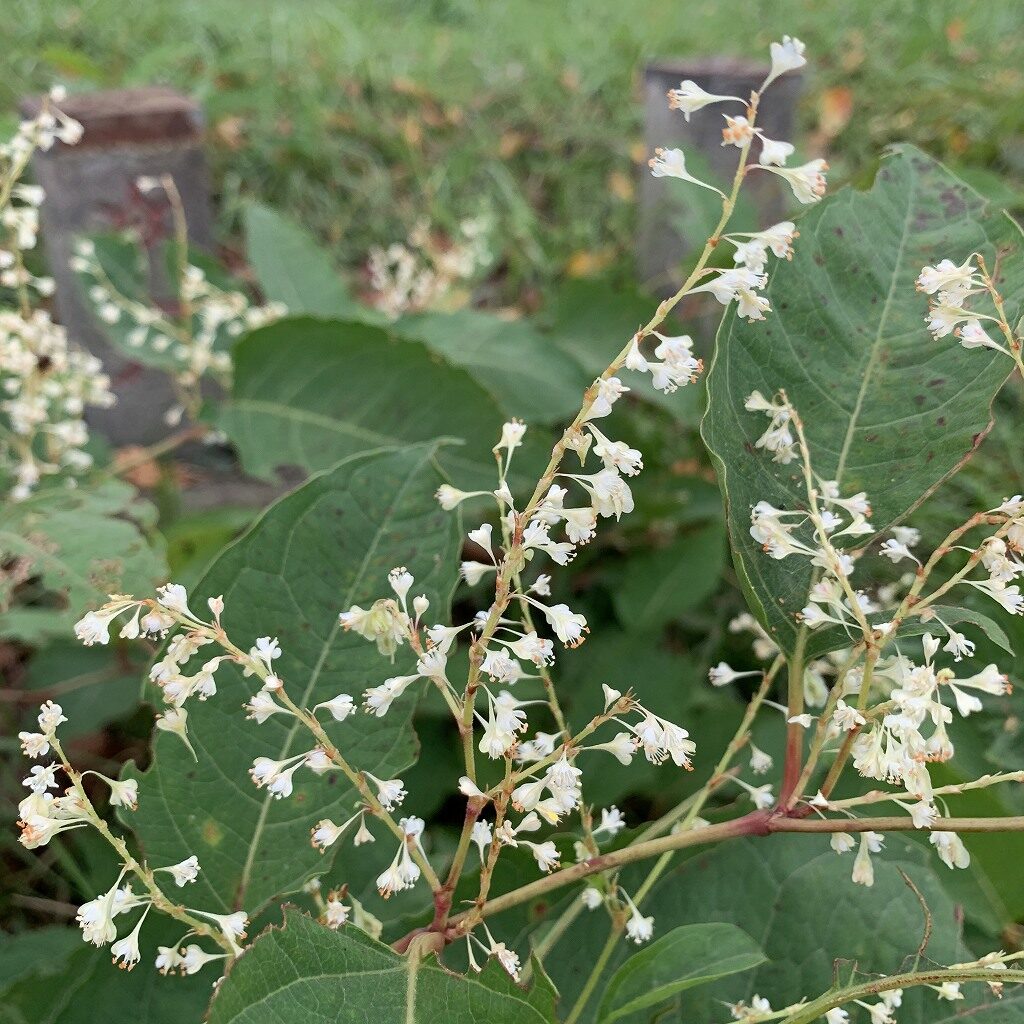イタドリの名前の由来は葉を揉んで切り傷などに被せると血が止まり、痛みが和らぐ「痛み取り」。茎を折ると「ポン」という音が鳴ります。
It is said that covering a cut with rubbing Japanese Knotweed leaves will stop bleeding and relieve pain. When you break the stem, you will hear a “pop” sound.
【仮名】イタドリ, スカンポ
【和名】虎杖, 酢模
【英名】Japanese Knotweed
【学名】Fallopia japonica
【誕生】10/ 05
【開花】07, 08, 09, 10月
【花色】White, Pink



イタドリ
イタドリの来歴
イタドリはタデ科ソバカズラ属の多年草です。日本では北海道から九州まで、国外では台湾、朝鮮半島、中国に分布し、日当たりが良く、やや湿ったところに群生。生長が早く、根茎も強いので、土壌浸食を防止する植物として世界中に移入されましたが、厄介な雑草になっています。
イタドリの名前
イタドリの名前の由来は、葉を揉んで切り傷などに被せると出血が止まり、痛みが和らぐため、「痛み取り」が転じたとされます。また、茎から繊維が採れるので「糸取り」が転じたとも。漢字の「虎杖」は茎が軽くて丈夫なので杖に使われ、紅色の斑紋が虎模様に似ているからです。
イタドリの姿形
イタドリは雌雄異株です。根茎は太く這い回り、茎は中空で直立。葉は互生で先端が尖り、下端が真っ直ぐな三角形です。花は萼片が5つに裂けますが、雄花は小さく、雄しべが長く8本、雌花は大きく、雌しべの花柱が3裂。花後はハート形の痩果が種子ごと風に乗って広がります。
イタドリの近縁
イタドリの変種「明月草」は「紅虎杖」とも呼ばれて花色が赤く、高地に自生。同属異種の「蔓毒溜」は江戸時代に薬用で中国から持ち込まれました。「大虎杖」は草丈も葉も一回り大きく、日本海側の山野に自生。「八丈虎杖」は草丈が低く、葉が厚く、伊豆諸島に分布しています。
イタドリの利用
イタドリの茎は皮をむいて食べられます。酸味があるので別名「スカンポ」。茎を折ると「ポン」という音が鳴ります。生食のほか、灰汁を抜いて酢の物や炒め物に、または漬物やジャムなどに加工。根茎は生薬「虎杖根」として、漢方で蕁麻疹、便秘、月経不順などに用いられます。
Japanese Knotweed
Japanese Knotweed is a perennial herb of the Polygonaceae family. Distributed in Japan from Hokkaido to Kyushu, and overseas in Taiwan, the Korean Peninsula, and China, it grows in colonies in sunny and slightly damp areas. It grows quickly and has a strong rhizome, so it has been introduced all over the world as a plant that prevents soil erosion, but it has become a troublesome weed.
Japanese Knotweed’s name means “get rid of pain”. This is because rubbing the leaves and covering cuts with them will stop the bleeding and ease the pain. It also means “to take the thread”, because the fiber can be taken from the stem. Its Kanji means tiger and cane. Because the stem is light and strong, it is used for sticks, and the red spots on the stem resemble a tiger pattern.
Japanese Knotweed is dioecious. The rhizome is thick and creeping, and the stem is hollow and erect. The leaves are alternate, triangular with pointed tips and straight bottoms. The flowers have five sepals, but the male flowers are small and have eight long stamens, while the female flowers are large and the style of the pistil is split into three. After flowering, the heart-shaped achene spreads with the wind along with the seeds.
Japanese Knotweed variety “compacta” has red flowers and grows naturally in highlands. The same genus and heterogeneous “multiflorum” was brought from China for medicinal purposes during the Edo period. “sachalinensis” has a slightly larger plant height and leaves, and grows naturally in the mountains and fields on the Sea of Japan side. “terminalis” has a short plant height and thick leaves, and is distributed in the Izu Islands.
Japanese Knotweed stem can be peeled and eaten. When the stem is broken, it makes a “pop” sound and has a sour taste when chewed. In addition to being eaten raw, the lye is removed and it is vinegared or stir-fried, or processed into pickles and jams. The rhizome is used as a herbal medicine “Tiger stick root” in Chinese medicine for urticaria, constipation, irregular menstruation, etc.


